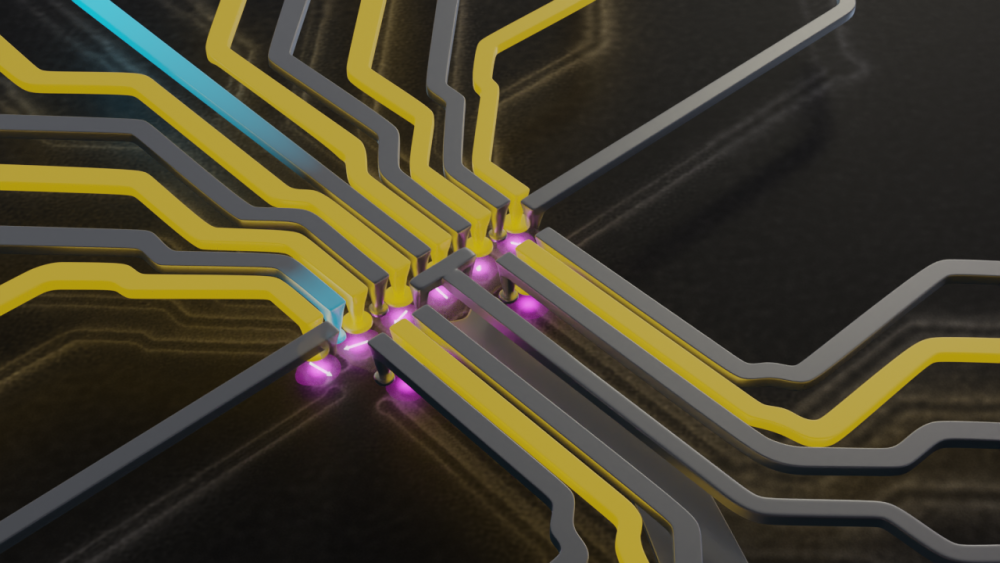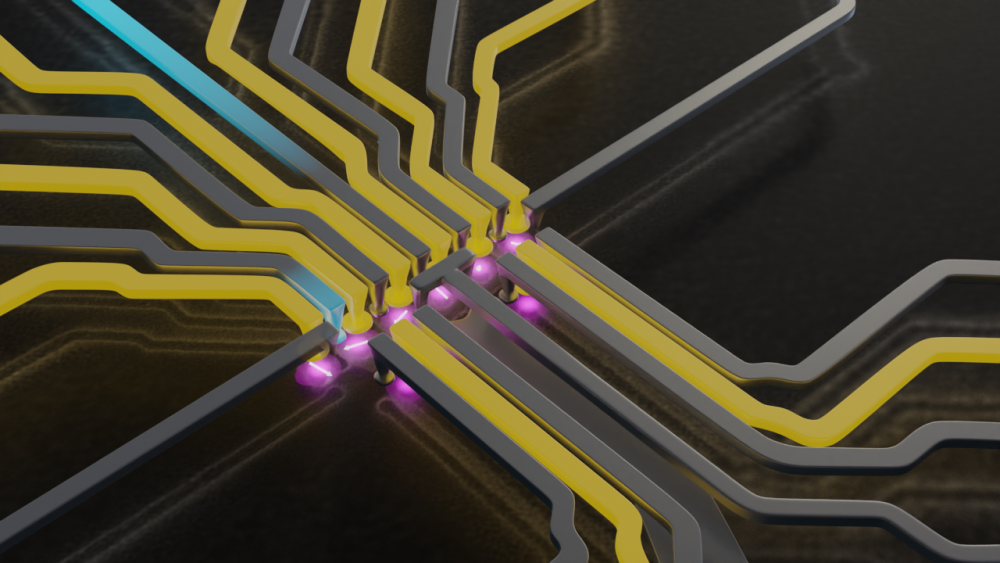Universal Quantum Logic through Spin Swapping
Twenty years ago, theorists proposed an approach for protecting fragile spin-based qubits against the decoherence from noisy inputs. The idea was to encode information in the qubits by swapping the spin states of neighboring electrons. Unlike the usual method of flipping spins, this swapping process would add no energy to the system. Researchers at HRL Laboratories in California have now realized that design in an electrically controlled, silicon-based platform [1]. Their device—which was presented last week at the APS March Meeting—demonstrates a low-error logic gate that can be used to perform any kind of quantum computational algorithm.
In most spin-based qubit designs, a qubit is a single spin with two states—“0” or “1”—which have different energies corresponding to the spin’s alignment with respect to an applied magnetic field. The qubit can be controlled by adding or removing energy from the system. That’s typically accomplished by irradiating the qubit with microwave photons at a frequency corresponding to the qubit’s energy level splitting. The qubit’s spin responds by flipping direction—like an on-off switch. This method is well established, but it suffers from decoherence—the qubit tends to lose its quantum information as the result of small inhomogeneities (noise) in the microwave radiation or magnetic field.
In contrast, the team’s approach creates a spin-based qubit whose “0” and “1” states have the same energy. Here the qubit states correspond to whether two electron spins in the qubit have antisymmetric (“0”) or symmetric (“1”) spin wave functions. Control over these states is offered by voltage pulses that “swap” the directions of neighboring spins without aligning them in a particular direction. These swaps, which are energy-conserving operations, change nothing when the two wave functions are symmetric, but they introduce a quantum phase of −1 when the wave functions are antisymmetric. Such swaps are actually partial swaps, meaning the voltage pulse is tuned so that the swapping can occur but there’s a certain probability that it doesn’t. “A partial swap is a quantum operation that leaves us in a superposition of ‘swapped’ and ‘not swapped,’” explains HRL team member Thaddeus Ladd. He and his colleagues use a complex sequence of partial swaps to encode information in a set of electron spins.
For the experiment, the HRL team fabricated six silicon quantum dots, forming two distinct qubits. Each dot traps a single electron, whose spin interacts with neighboring spins through voltage pulses delivered to metal gates. The researchers demonstrated two quantum operations—called CNOT and SWAP—with the two qubits. Doing so required complex sequences of partial swaps across the six spins, involving thousands of precisely calibrated voltage pulses that switch on and off a hundred million times per second. The measured errors in these operations were low, characterized by a “fidelity” of around 97%. “With a healthy dose of mathematics, one may show that this [method] of partial swapping of spins is sufficient to perform any quantum operation on a desired, limited set of states of many spins,” says Ladd.
This approach offers two key advantages compared to conventional single-spin qubits. First, it avoids the need for various hardware integration to control magnetic fields and mismatched phases. Second, it avoids the crosstalk generated by a microwave input. These advantages avoid microscopic sources of error and improve the fidelity of qubit control. The price is that each qubit needs three quantum dots to form a single qubit, and each basic operation consists of a long complex sequence of pulses. Ladd says getting the device to work was no easy feat of hardware fabrication and software development.
The researchers built their new six-dot device using a technique that they’ve been developing called SLEDGE (single-layer etch-defined gate electrode). This platform uses an electron beam to pattern dot-shaped gates onto a plane and subsequently interconnect the gates via metal leads. Andrea Morello, a quantum physicist at the University of New South Wales, Australia, is impressed with the lab’s new device. “[HRL’s] state-of-the-art device fabrication capabilities allowed the researchers to fabricate quantum dots with exquisite precision and reproducibility such that even a complex six-dot device exhibited reliable behavior,” Morello says.
Ladd clarifies that the technology won’t lead to practical quantum computing until millions of qubits can communicate with one another. Although HRL’s proof of concept avoids many problems associated with microwave control, there are other challenges, such as keeping the system cold and ensuring uniformity in the etched quantum-dot patterns, which will become more difficult as more qubits are included. “I’m not claiming ours is the best or fastest or smartest qubit design. But I think it’s one of the most interesting, not least because it connects to the fundamental computing problem of whether you must input energy to perform a computation,” says Ladd.
According to Morello, the swapping approach would require big changes to the way people normally operate qubits, but he thinks a “compelling” argument can be made that removing the need for microwave signals may simplify the job of qubit control. “The future will tell whether this bold choice pays off when enlarging the quantum processor to ever more qubits,” he says.
–Rachel Berkowitz
Rachel Berkowitz is a Corresponding Editor for Physics Magazine based in Vancouver, Canada.
References
- A. J. Weinstein et al., “Universal logic with encoded spin qubits in silicon,” Nature (2023).





